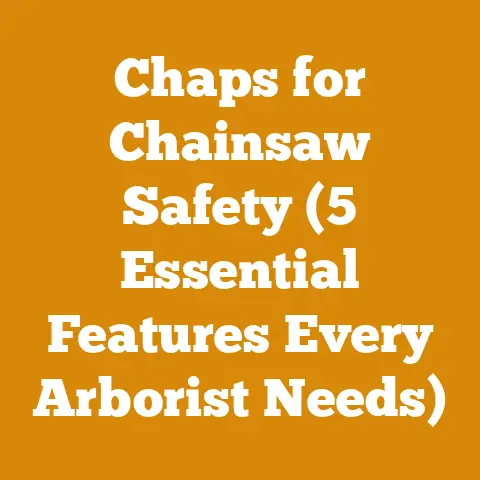Cost of Chainsaw Sharpening (5 Pro Tips for Peak Cutting)
Cost of Chainsaw Sharpening (5 Pro Tips for Peak Cutting)
As someone who’s spent a good chunk of my life around wood, from felling trees to splitting firewood for those cozy winter nights, I understand the importance of a sharp chainsaw. But beyond the satisfaction of a clean, efficient cut, there’s a real economic impact to consider. We are increasingly aware of our impact on the environment and the importance of making eco-conscious choices. This extends to how we manage our tools and resources, including the often-overlooked aspect of chainsaw maintenance. Keeping your chainsaw properly sharpened isn’t just about convenience; it’s about sustainability, safety, and saving money in the long run. A dull chain wastes fuel, puts unnecessary strain on your saw, and increases the risk of kickback, not to mention the extra effort you’ll need to put in.
In this article, I’ll be diving deep into the costs associated with chainsaw sharpening, giving you the insights you need to make informed decisions. I’ll also share my top 5 pro tips for maintaining a razor-sharp chain, so you can maximize your cutting efficiency and minimize your expenses. Let’s get started!
Understanding the Costs of Chainsaw Sharpening: A Deep Dive
Before we get to the pro tips, let’s break down the different cost factors involved in keeping your chainsaw chain sharp. This isn’t just about the price of a sharpening service; it’s about the overall impact on your wallet and your workflow.
1. The Cost of Professional Sharpening Services
The most straightforward cost is what you pay someone else to sharpen your chain. Prices can vary significantly depending on your location, the type of chain, and the service provider.
-
Average Price Range: In the US, you can typically expect to pay between $10 and $25 for a professional chainsaw sharpening service. In Europe, prices might range from €8 to €20. In Australia, expect to pay AUD $15 to AUD $30. These are just averages, and you might find lower or higher prices depending on the specific shop.
-
Factors Affecting Price:
- Chain Type: Specialty chains, like those with carbide tips, often cost more to sharpen due to the specialized equipment and expertise required.
- Chain Condition: A heavily damaged chain with broken or severely worn teeth will take longer to sharpen and may incur additional charges.
- Service Provider: Large equipment dealers or specialized chainsaw shops tend to charge more than smaller hardware stores or independent sharpeners.
- Location: Urban areas with higher overhead costs generally have higher prices than rural areas.
- Real-World Examples: I remember once taking a particularly beat-up chain to a local shop after a tough job clearing some storm damage. They charged me $20, which was on the higher end, but the chain came back looking brand new. Another time, I took a relatively new chain to a hardware store, and they only charged me $12.
2. The Cost of DIY Sharpening
Sharpening your own chainsaw chain can save you money in the long run, but it also requires an initial investment in tools and time.
-
Initial Investment:
- Hand Filing Kit: A basic hand filing kit, including a file guide, round files, and a flat file, typically costs between $20 and $50.
- Electric Chain Sharpener: An electric chain sharpener can range from $50 for a basic model to $200 or more for a professional-grade sharpener.
- Safety Gear: Don’t forget safety glasses and gloves, which can cost around $10 to $20.
-
Ongoing Costs:
-
File Replacement: Files wear out over time and need to be replaced. A set of replacement files can cost around $10 to $20.
- Grinding Wheels (for electric sharpeners): Grinding wheels also wear down and need to be replaced. A replacement wheel can cost around $10 to $30.
-
Time Investment:
-
Sharpening a chain by hand can take 15-30 minutes, depending on your experience and the condition of the chain.
- Using an electric sharpener can reduce the time to 5-10 minutes.
-
Hidden Costs:
-
Learning Curve: It takes time and practice to learn how to sharpen a chainsaw chain properly. You might damage a chain or two while you’re learning.
- Mistakes: Improper sharpening can damage the chain or even the chainsaw itself, leading to costly repairs.
- My Experience: I started sharpening my own chains years ago with a simple hand filing kit. It took me a while to get the hang of it, and I definitely made some mistakes along the way. But over time, I got better and faster, and now I can sharpen a chain in about 15 minutes. I eventually invested in an electric sharpener, which has made the process even quicker and easier.
3. The Cost of a Dull Chain: Beyond the Obvious
The costs of a dull chainsaw chain extend far beyond the price of sharpening. These indirect costs can add up quickly and significantly impact your overall expenses.
- Increased Fuel Consumption: A dull chain requires more power to cut through wood, which translates to increased fuel consumption. Studies have shown that a dull chain can increase fuel consumption by as much as 20%.
- Increased Wear and Tear on the Chainsaw: A dull chain puts extra strain on the chainsaw engine, bar, and sprocket, leading to increased wear and tear and potentially costly repairs.
- Reduced Cutting Efficiency: A dull chain cuts slower, which means it takes longer to complete a job. This can be a significant factor if you’re working on a large project or getting paid by the hour.
- Increased Risk of Kickback: A dull chain is more likely to kick back, which can be dangerous and cause serious injury. Kickback can also damage the chainsaw.
- Lower Quality Cuts: A dull chain produces rough, uneven cuts, which can be a problem if you’re working on a project that requires precision.
- Lost Productivity: All of the above factors contribute to lost productivity, which can be a significant cost if you’re running a business.
- Data and Statistics: According to the US Department of Labor, chainsaw accidents result in thousands of injuries each year, many of which are caused by kickback from dull chains. These injuries can lead to medical expenses, lost wages, and even permanent disability.
- Personal Anecdote: I once spent an entire day struggling to cut through a pile of firewood with a dull chain. I used almost twice as much fuel as I normally would, and I was exhausted by the end of the day. I realized that I had wasted more money on fuel and time than it would have cost to simply sharpen the chain.
4. Cost Comparison: Professional vs. DIY Sharpening
To help you make an informed decision, let’s compare the costs of professional sharpening services with the costs of DIY sharpening.
| Cost Category | Professional Sharpening | DIY Sharpening (Hand Filing) | DIY Sharpening (Electric) |
|---|---|---|---|
| Initial Investment | $0 | $20 – $50 | $50 – $200+ |
| Per-Sharpening Cost | $10 – $25 | $1 – $3 (file wear) | $1 – $5 (wheel wear) |
| Time per Sharpening | 0 minutes | 15 – 30 minutes | 5 – 10 minutes |
| Skill Level Required | None | Moderate | Moderate |
| Potential for Damage | Low | Moderate | Low |
| Long-Term Cost (5 years) | $100 – $250+ (10 sharpenings/year) | $70 – $100+ (including initial cost) | $100 – $300+ (including initial cost) |
Analysis:
- Professional Sharpening: This is the most convenient option, but it can be the most expensive in the long run if you sharpen your chain frequently.
- DIY Sharpening (Hand Filing): This is the most affordable option upfront, but it requires more time and skill. It’s a good choice if you only need to sharpen your chain occasionally and you’re willing to invest the time to learn how to do it properly.
- DIY Sharpening (Electric): This option offers a good balance between cost and convenience. It requires a larger initial investment, but it can save you time and money in the long run if you sharpen your chain frequently.
5. Factoring in Location, Wood Type, and Seasonality
The cost of chainsaw sharpening, and indeed all aspects of wood processing, can vary significantly depending on several external factors.
- Location: As mentioned earlier, urban areas tend to have higher prices for professional sharpening services due to higher overhead costs. Rural areas may offer lower prices, but you might have to travel further to find a service provider.
- Wood Type: Cutting hardwoods like oak or maple will dull your chain faster than cutting softwoods like pine or fir. This means you’ll need to sharpen your chain more frequently, which will increase your overall costs.
- Seasonality: During peak firewood cutting season (fall and winter), sharpening services may be in higher demand, which could lead to increased prices or longer wait times.
- Accessibility: If you’re working in a remote area, it might be more difficult and expensive to get your chain sharpened professionally. In this case, DIY sharpening might be the more practical option.
- Timber Prices and Fuelwood Market Rates: The overall economic climate of the timber industry can also impact your costs. When timber prices are high, there may be more demand for chainsaw sharpening services, which could drive up prices. Similarly, fluctuations in fuelwood market rates can affect the profitability of your firewood business, which could influence your willingness to spend money on chainsaw maintenance.
- Global and Regional Statistics: According to a report by the Food and Agriculture Organization of the United Nations (FAO), global timber prices have been volatile in recent years due to factors such as climate change, trade disputes, and economic slowdowns. These fluctuations can have a ripple effect on the entire wood processing industry, including the cost of chainsaw sharpening.
5 Pro Tips for Peak Cutting and Cost Savings
Now that we’ve covered the various costs associated with chainsaw sharpening, let’s move on to my top 5 pro tips for maintaining a razor-sharp chain and saving money in the process.
Tip 1: Sharpen Regularly, Don’t Wait Until It’s Dull
This is the most important tip of all. Don’t wait until your chain is completely dull before sharpening it. Sharpening a slightly dull chain is much easier and faster than sharpening a severely dull chain. It also puts less stress on your tools and reduces the risk of damaging the chain.
- How Often to Sharpen: A good rule of thumb is to sharpen your chain after every 2-3 hours of use, or whenever you notice a decrease in cutting performance.
-
Signs of a Dull Chain:
- The saw produces sawdust instead of chips.
- The saw requires more pressure to cut through wood.
- The saw pulls to one side while cutting.
- The saw vibrates excessively.
- The saw smokes or burns the wood.
- My Approach: I usually sharpen my chain after each tank of gas. This ensures that my chain is always sharp and ready to go.
Tip 2: Use the Right Tools and Techniques
Using the right tools and techniques is essential for achieving a sharp, consistent edge and preventing damage to your chain.
- Choosing the Right File: Use a file that is specifically designed for chainsaw chains. The file should be the correct diameter for the size of your chain. Refer to your chainsaw’s manual for the recommended file size.
- Using a File Guide: A file guide helps you maintain the correct angle and depth while sharpening. This is especially important if you’re new to chainsaw sharpening.
- Maintaining the Correct Angle: The correct sharpening angle is typically printed on the file guide. Make sure to maintain this angle throughout the sharpening process.
- Filing in One Direction: Always file in one direction, from the inside of the cutter to the outside. This helps to create a clean, sharp edge.
- Counting Strokes: Use the same number of strokes on each cutter to ensure that they are all the same length.
- Lowering the Depth Gauges: After sharpening, you may need to lower the depth gauges (also known as rakers) to ensure that the chain cuts properly. Use a depth gauge tool and a flat file to lower the depth gauges to the recommended height.
- Electric Sharpener Tips: If you’re using an electric sharpener, make sure to follow the manufacturer’s instructions carefully. Use light pressure and avoid overheating the chain.
- Safety First: Always wear safety glasses and gloves when sharpening your chainsaw chain.
- Visual Aids: There are many excellent videos and tutorials online that demonstrate proper chainsaw sharpening techniques. Take the time to watch these videos and learn from experienced professionals.
Tip 3: Keep Your Chain Clean and Well-Lubricated
A clean, well-lubricated chain will cut more efficiently and last longer.
- Cleaning the Chain: After each use, clean your chain with a brush and solvent to remove sawdust, sap, and other debris.
- Oiling the Chain: Use a high-quality bar and chain oil to lubricate the chain. Check the oil level frequently and refill as needed.
- Proper Tension: Maintain the proper chain tension. A chain that is too loose can come off the bar, while a chain that is too tight can overheat and wear out quickly.
- Bar Maintenance: Regularly clean and lubricate the chainsaw bar. Check the bar for wear and damage and replace it if necessary.
- Choosing the Right Oil: Use a bar and chain oil that is appropriate for the type of wood you’re cutting and the temperature conditions. In cold weather, use a thinner oil to ensure proper lubrication.
- Biodegradable Oils: Consider using a biodegradable bar and chain oil to reduce your environmental impact.
- My Routine: I always clean and oil my chain after each use, and I check the chain tension before each use. This simple routine has helped me to extend the life of my chains and keep my chainsaw running smoothly.
Tip 4: Avoid Cutting Dirty or Contaminated Wood
Cutting dirty or contaminated wood can quickly dull your chain and damage your chainsaw.
- Avoid Cutting Wood That is Lying on the Ground: Wood that is lying on the ground is often covered in dirt, sand, and rocks, which can quickly dull your chain.
- Remove Bark Before Cutting: Bark can also contain dirt and debris. Remove the bark from the area you’re going to cut before you start sawing.
- Avoid Cutting Wood That Contains Nails or Metal: Nails and metal can severely damage your chain and chainsaw. Use a metal detector to check the wood before cutting it.
- Be Careful When Cutting Near Fences or Buildings: Fences and buildings may contain nails or other metal objects. Be careful when cutting near these structures.
- Use Common Sense: If you suspect that a piece of wood may contain dirt, rocks, or metal, don’t cut it. It’s better to be safe than sorry.
- The Unexpected Find: I once found a rusty nail embedded in a log while cutting firewood. I was lucky that I didn’t hit it with my chain, but it was a close call. This experience taught me the importance of being vigilant when cutting wood.
Tip 5: Invest in Quality Chains and Equipment
Investing in quality chains and equipment may cost more upfront, but it can save you money in the long run.
- Choose a Reputable Brand: Choose a chainsaw and chain from a reputable brand that is known for quality and durability.
- Consider Carbide-Tipped Chains: Carbide-tipped chains are more expensive than standard chains, but they stay sharp longer and are more resistant to damage. They are a good choice if you frequently cut dirty or contaminated wood.
- Use the Right Chainsaw for the Job: Using a chainsaw that is too small for the job can put extra strain on the engine and chain, leading to increased wear and tear.
- Maintain Your Equipment Properly: Regularly maintain your chainsaw and other equipment according to the manufacturer’s instructions. This will help to extend the life of your equipment and prevent costly repairs.
- Sharpener Quality: Investing in a high-quality chainsaw sharpener (whether hand file or electric) can make a significant difference in the quality and longevity of your chain sharpening.
- Balancing Cost and Value: While it’s tempting to go for the cheapest option, remember that quality often pays for itself in the long run.
- My Recommendation: I’ve found that investing in high-quality chains and equipment has been well worth the cost. My chains last longer, my chainsaw runs smoother, and I spend less time and money on repairs.
Budgeting for Chainsaw Maintenance: A Practical Guide
Now that you understand the costs of chainsaw sharpening and have learned my top 5 pro tips, let’s talk about budgeting for chainsaw maintenance.
- Estimate Your Usage: Estimate how many hours you’ll be using your chainsaw each year. This will help you to determine how often you’ll need to sharpen your chain and how much you’ll need to budget for sharpening services or DIY sharpening supplies.
- Track Your Expenses: Keep track of your chainsaw maintenance expenses, including sharpening services, files, grinding wheels, bar and chain oil, and repairs. This will help you to identify areas where you can save money.
- Set Aside a Budget: Set aside a specific amount of money each year for chainsaw maintenance. This will help you to avoid unexpected expenses and ensure that your chainsaw is always in good working condition.
- Consider a Maintenance Plan: Some chainsaw dealers offer maintenance plans that cover sharpening, repairs, and other services. These plans can be a good value if you use your chainsaw frequently.
- Factor in Depreciation: Remember to factor in the depreciation of your chainsaw when budgeting for maintenance. A chainsaw that is several years old will likely require more maintenance than a new chainsaw.
- Contingency Fund: Always have a contingency fund for unexpected repairs or replacements.
- Spreadsheet Tracking: I personally use a simple spreadsheet to track my chainsaw maintenance expenses. This allows me to see at a glance how much I’m spending on sharpening, oil, and other supplies.
-
Sample Budget Breakdown:
- Chainsaw Sharpening: $50 – $100 per year (depending on usage and sharpening method)
- Bar and Chain Oil: $20 – $40 per year
- Files and Grinding Wheels: $10 – $30 per year
- Repairs: $50 – $200+ per year (depending on the age and condition of your chainsaw)
- Total Annual Budget: $130 – $370+
The Math Behind Wood Processing: Calculations and Formulas
Understanding the math behind wood processing can help you to make informed decisions about your projects and budget your resources effectively.
-
Calculating Volume of Logs:
-
Board Feet: A board foot is a unit of measurement for lumber that is equal to 1 inch thick, 12 inches wide, and 12 inches long. The formula for calculating the board feet in a log is:
Board Feet = (Diameter in inches - 4) * (Length in feet) / 16This formula is based on the Doyle Log Scale, which is commonly used in the United States. * Cords: A cord is a unit of measurement for firewood that is equal to a stack of wood that is 4 feet high, 4 feet wide, and 8 feet long. The formula for estimating the number of cords in a pile of wood is:
Cords = (Height in feet * Width in feet * Length in feet) / 128* Estimating Drying Time: -
The drying time for firewood depends on several factors, including the species of wood, the moisture content, the climate, and the stacking method. A general rule of thumb is that firewood needs to dry for at least 6 months to reach a moisture content of 20% or less.
- You can use a moisture meter to measure the moisture content of your firewood. A moisture meter is a small, handheld device that measures the electrical resistance of the wood. The lower the moisture content, the lower the resistance.
-
The formula for estimating the drying time for firewood is:
Drying Time (months) = (Initial Moisture Content - Target Moisture Content) / Drying RateThe drying rate depends on the climate and the stacking method. In a warm, dry climate with good air circulation, the drying rate might be 1-2% per week. In a cool, humid climate with poor air circulation, the drying rate might be 0.5% per week. * Fuel Consumption Calculations:
-
To estimate your chainsaw’s fuel consumption, you can use the following formula:
Fuel Consumption (gallons per hour) = Engine Horsepower * Brake Specific Fuel Consumption (BSFC)The BSFC is a measure of how efficiently an engine uses fuel. It is typically expressed in pounds of fuel per horsepower-hour. You can find the BSFC for your chainsaw’s engine in the manufacturer’s specifications. * Cost Per Cord Calculations:
-
To calculate the cost per cord of firewood, you need to add up all of your expenses, including the cost of the wood, the cost of chainsaw maintenance, the cost of fuel, and the cost of labor. Then, divide the total cost by the number of cords you produce.
-
Actionable Takeaways and Next Steps
Okay, we’ve covered a lot of ground! Here’s a summary of the key takeaways and some actionable steps you can take to improve your chainsaw maintenance and budgeting.
- Understand the Costs: Be aware of the various costs associated with chainsaw sharpening, including professional services, DIY supplies, and the hidden costs of a dull chain.
- Sharpen Regularly: Don’t wait until your chain is completely dull before sharpening it. Sharpen after every 2-3 hours of use, or whenever you notice a decrease in cutting performance.
- Use the Right Tools and Techniques: Use the correct file, file guide, and sharpening angle. Watch videos and learn from experienced professionals.
- Keep Your Chain Clean and Well-Lubricated: Clean and oil your chain after each use. Maintain proper chain tension.
- Avoid Cutting Dirty or Contaminated Wood: Be careful when cutting wood that is lying on the ground, contains nails or metal, or is near fences or buildings.
- Invest in Quality Chains and Equipment: Choose a reputable brand and consider carbide-tipped chains.
- Budget for Chainsaw Maintenance: Estimate your usage, track your expenses, and set aside a budget for sharpening, oil, repairs, and replacements.
- Do the Math: Understand the formulas for calculating volume of logs, estimating drying time, and calculating fuel consumption.
- Assess Your Skills and Resources: Decide whether you’re better off sharpening your chain professionally or doing it yourself.
- Start Small: If you’re new to chainsaw sharpening, start with a simple hand filing kit and practice on an old chain.
- Seek Advice: Don’t be afraid to ask for advice from experienced chainsaw users or professionals.
- Stay Safe: Always wear safety glasses and gloves when sharpening your chainsaw chain.
Next Steps:
- Assess your current chainsaw sharpening situation: Are you happy with the performance of your chain? Are you spending too much money on sharpening services?
- Decide whether to sharpen professionally or DIY: Consider your budget, time constraints, and skill level.
- If DIY, invest in the necessary tools and supplies: Choose a quality file kit or electric sharpener.
- Learn proper sharpening techniques: Watch videos, read tutorials, and practice on an old chain.
- Start sharpening your chain regularly: Don’t wait until it’s completely dull.
- Track your expenses and adjust your budget as needed.
- Enjoy the benefits of a sharp chainsaw: Increased cutting efficiency, reduced fuel consumption, and improved safety.
Final Thoughts: A Sharp Chain for a Sharper Future
Maintaining a sharp chainsaw chain is not just about saving money. It’s about safety, efficiency, and prolonging the life of your equipment. By following these tips and budgeting wisely, you can keep your chainsaw running smoothly and tackle your wood processing projects with confidence. Remember, a well-maintained chainsaw is a valuable tool that can provide years of reliable service. So, take care of your chainsaw, and it will take care of you. And remember that small changes in our habits can lead to a more sustainable and efficient way of managing resources. By embracing these practices, we not only save money but also contribute to a healthier planet.
Now, get out there and make some sawdust! Just remember to keep that chain sharp!






